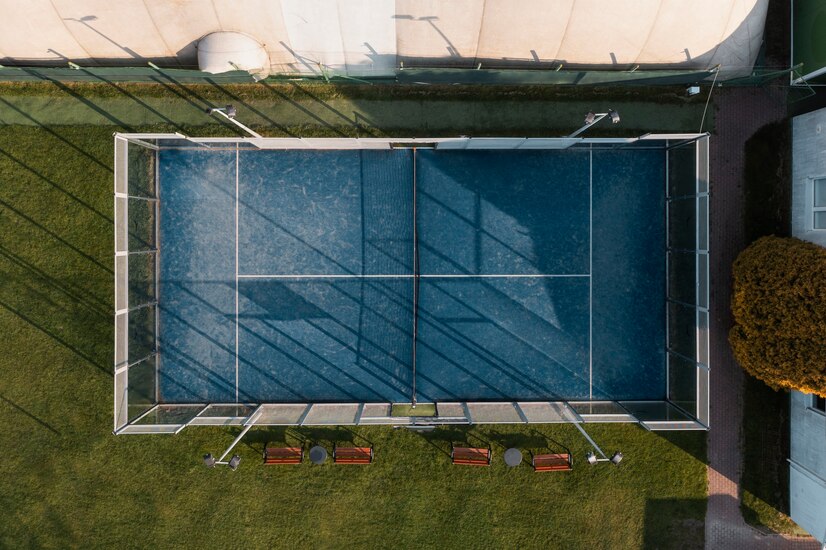To play padel in the best possible conditions, it is essential to understand the dimensions of a padel court and the standards that govern it. This information is crucial not only for players, but also for clubs and individuals wishing to build a padel court. In this article, we will explore in detail the dimensions and recommendations for a padel court, to ensure that the game is played to the full.
Standard dimensions of a padel court
The dimensions of a padel court are set by the International Padel Federation (FIP) to ensure uniformity and equality during competitions. A standard padel court is 20 metres long and 10 metres wide. These dimensions are the same for doubles and singles matches, although singles matches are less common. The court is divided in two by a net whose maximum height is 88 centimetres in the centre and 92 centimetres on the sides. This net separates the two halves of the pitch symmetrically. Each half-court is therefore 10 metres long and 10 metres wide, subdivided by service and back lines.
Specific zones on a padel court
A padel court has several specific areas, each with its own characteristics and rules. Here are the main zones to be aware of:
- The service area: Located on either side of the net, the service area is delimited by a service line parallel to the net, at a distance of 3 metres. It is subdivided into two equal zones by a central line perpendicular to the net.
- The baseline zone: This zone extends from the service line to the back wall of the court. This is the area where most exchanges take place.
- The side and back walls: These walls, often made of glass or mesh, are an integral part of the game, allowing bounces that add an extra strategic dimension to padel.
Materials and construction of walls on a padel court
The walls of a padel court play an essential role in the game. They need to be constructed from specific materials to ensure their durability and interactivity with the ball. Most padel courts have walls made of toughened glass or wire mesh. Toughened glass walls, which are 10 to 12 millimetres thick, not only allow the ball to bounce accurately, but also provide optimum visibility for spectators. Wire mesh walls are generally used on the sides of the pitch for their flexibility and strength.
The playing surface: materials and maintenance
The playing surface of a padel court must offer optimum grip and comfort for players. The materials most commonly used for the surface are :
- Synthetic carpet: This type of surface is valued for its ability to absorb shock and reduce the risk of injury to players.
- Artificial grass: Offering excellent durability and grip, artificial grass is also easy to maintain.
- Porous concrete: Used primarily for its strength, this material nevertheless requires regular maintenance to stay in good condition.
Maintaining the playing surface is crucial to ensuring optimum playing conditions. This includes regular cleaning to remove debris, as well as periodic inspection to detect any deterioration.
Safety standards for a padel court
Player safety is a primary concern when building a padel court. Safety standards include specifications for the walls, net and floor of the court:
- Net: Must be securely fastened to avoid any risk of injury.
- Walls: Must be made of sturdy and safe materials, with no risk of breaking or collapsing.
- The floor: Must be non-slip and well maintained to prevent falls and injuries.
It is also advisable to install additional protection, such as padding on net posts and wall corners, to minimise the risk of injury in the event of a collision.
Lighting and playing conditions
Lighting is another crucial element for a padel court, especially if you plan to play in the evening. Good lighting not only allows the ball to be seen more clearly, but also improves player safety. For optimum lighting, it is recommended that you use specific sports court luminaires, which provide an even distribution of light without dazzling the players. Standards suggest a light intensity of 300 to 500 lux for recreational pitches, and 500 to 700 lux for competition pitches.
Recommendations for building a padel court
Building a padel court requires careful planning and compliance with the standards set by the International Padel Federation. Here are a few recommendations:
- Choose the right location: The court should be located in a well-drained area with easy access for players and spectators.
- Respect dimensions and standards: Make sure the court respects standard dimensions and safety specifications.
- Use quality materials: Invest in high-quality, durable materials for the playing surface and walls.
- Provide good lighting: Install a lighting system that complies with standards so that games can be played in the evening.
Equipment and accessories needed for a padel court
To complete a padel court, certain equipment and accessories are essential:
- Nets: Must comply with height and tension standards.
- Benches: For players and coaches.
- Waste bins: To keep the court clean.
- Scoreboards: For keeping track of match scores.
Additional accessories such as racket holders and ball dispensers can improve the comfort and practicality of the area.
The cost of building a padel court
The cost of building a padel court depends on a number of factors, including the materials used, the region and the equipment installed. Typically, the cost can vary between €15,000 and €50,000 for a standard court, so it’s crucial to get detailed quotes from several suppliers and compare options before making a decision. Long-term maintenance costs should also be factored into the overall budget. By following these recommendations and adhering to the established standards, you can create a padel court that meets players’ expectations and guarantees a safe and enjoyable playing experience.

